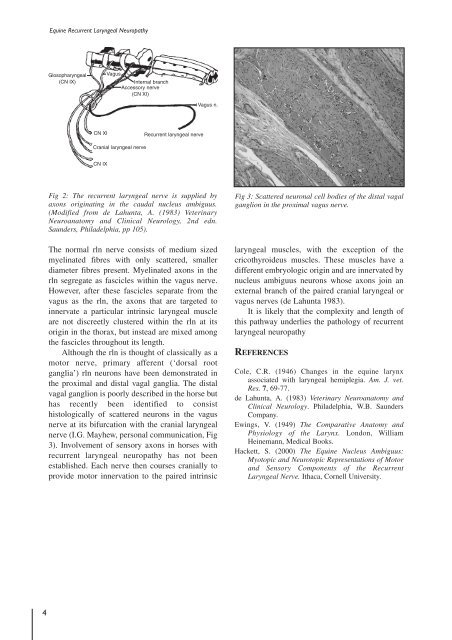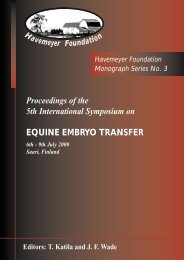Proceedings of a Workshop on - The Havemeyer Foundation
Proceedings of a Workshop on - The Havemeyer Foundation
Proceedings of a Workshop on - The Havemeyer Foundation
You also want an ePaper? Increase the reach of your titles
YUMPU automatically turns print PDFs into web optimized ePapers that Google loves.
Equine Recurrent Laryngeal Neuropathy<br />
Glosopharyngeal<br />
(CN IX)<br />
Vagus<br />
Internal branch<br />
Accessory nerve<br />
(CN XI)<br />
Vagus n.<br />
CN XI<br />
Recurrent laryngeal nerve<br />
Cranial laryngeal nerve<br />
CN IX<br />
Fig 2: <strong>The</strong> recurrent laryngeal nerve is supplied by<br />
ax<strong>on</strong>s originating in the caudal nucleus ambiguus.<br />
(Modified from de Lahunta, A. (1983) Veterinary<br />
Neuroanatomy and Clinical Neurology, 2nd edn.<br />
Saunders, Philadelphia, pp 105).<br />
<strong>The</strong> normal rln nerve c<strong>on</strong>sists <str<strong>on</strong>g>of</str<strong>on</strong>g> medium sized<br />
myelinated fibres with <strong>on</strong>ly scattered, smaller<br />
diameter fibres present. Myelinated ax<strong>on</strong>s in the<br />
rln segregate as fascicles within the vagus nerve.<br />
However, after these fascicles separate from the<br />
vagus as the rln, the ax<strong>on</strong>s that are targeted to<br />
innervate a particular intrinsic laryngeal muscle<br />
are not discreetly clustered within the rln at its<br />
origin in the thorax, but instead are mixed am<strong>on</strong>g<br />
the fascicles throughout its length.<br />
Although the rln is thought <str<strong>on</strong>g>of</str<strong>on</strong>g> classically as a<br />
motor nerve, primary afferent (‘dorsal root<br />
ganglia’) rln neur<strong>on</strong>s have been dem<strong>on</strong>strated in<br />
the proximal and distal vagal ganglia. <strong>The</strong> distal<br />
vagal gangli<strong>on</strong> is poorly described in the horse but<br />
has recently been identified to c<strong>on</strong>sist<br />
histologically <str<strong>on</strong>g>of</str<strong>on</strong>g> scattered neur<strong>on</strong>s in the vagus<br />
nerve at its bifurcati<strong>on</strong> with the cranial laryngeal<br />
nerve (I.G. Mayhew, pers<strong>on</strong>al communicati<strong>on</strong>, Fig<br />
3). Involvement <str<strong>on</strong>g>of</str<strong>on</strong>g> sensory ax<strong>on</strong>s in horses with<br />
recurrent laryngeal neuropathy has not been<br />
established. Each nerve then courses cranially to<br />
provide motor innervati<strong>on</strong> to the paired intrinsic<br />
Fig 3: Scattered neur<strong>on</strong>al cell bodies <str<strong>on</strong>g>of</str<strong>on</strong>g> the distal vagal<br />
gangli<strong>on</strong> in the proximal vagus nerve.<br />
laryngeal muscles, with the excepti<strong>on</strong> <str<strong>on</strong>g>of</str<strong>on</strong>g> the<br />
cricothyroideus muscles. <strong>The</strong>se muscles have a<br />
different embryologic origin and are innervated by<br />
nucleus ambiguus neur<strong>on</strong>s whose ax<strong>on</strong>s join an<br />
external branch <str<strong>on</strong>g>of</str<strong>on</strong>g> the paired cranial laryngeal or<br />
vagus nerves (de Lahunta 1983).<br />
It is likely that the complexity and length <str<strong>on</strong>g>of</str<strong>on</strong>g><br />
this pathway underlies the pathology <str<strong>on</strong>g>of</str<strong>on</strong>g> recurrent<br />
laryngeal neuropathy<br />
REFERENCES<br />
Cole, C.R. (1946) Changes in the equine larynx<br />
associated with laryngeal hemiplegia. Am. J. vet.<br />
Res. 7, 69-77.<br />
de Lahunta, A. (1983) Veterinary Neuroanatomy and<br />
Clinical Neurology. Philadelphia, W.B. Saunders<br />
Company.<br />
Ewings, V. (1949) <strong>The</strong> Comparative Anatomy and<br />
Physiology <str<strong>on</strong>g>of</str<strong>on</strong>g> the Larynx. L<strong>on</strong>d<strong>on</strong>, William<br />
Heinemann, Medical Books.<br />
Hackett, S. (2000) <strong>The</strong> Equine Nucleus Ambiguus:<br />
Myotopic and Neurotopic Representati<strong>on</strong>s <str<strong>on</strong>g>of</str<strong>on</strong>g> Motor<br />
and Sensory Comp<strong>on</strong>ents <str<strong>on</strong>g>of</str<strong>on</strong>g> the Recurrent<br />
Laryngeal Nerve. Ithaca, Cornell University.<br />
4








